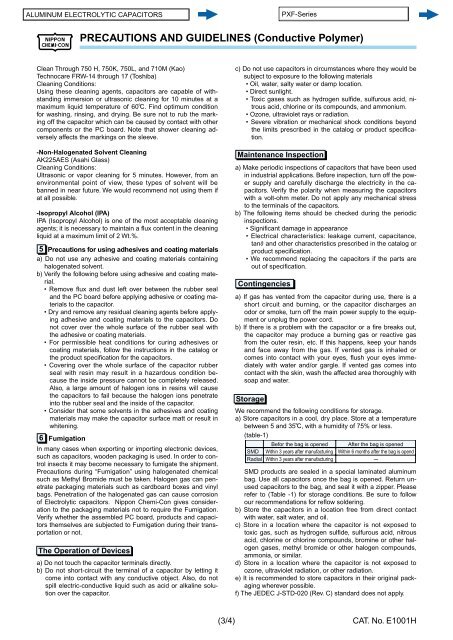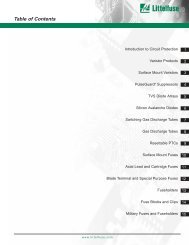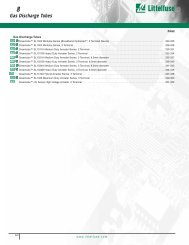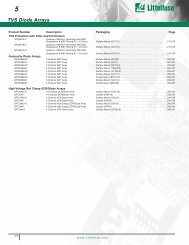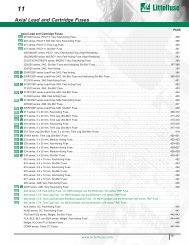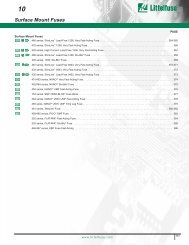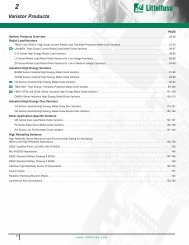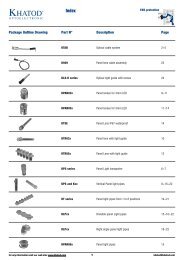ALUMINUM ELECTROLYTIC CAPACITORS
ALUMINUM ELECTROLYTIC CAPACITORS
ALUMINUM ELECTROLYTIC CAPACITORS
You also want an ePaper? Increase the reach of your titles
YUMPU automatically turns print PDFs into web optimized ePapers that Google loves.
PRECAUTIONS AND GUIDELINES (Conductive Polymer)<br />
Clean Through 750 H, 750K, 750L, and 710M (Kao)<br />
Technocare FRW-14 through 17 (Toshiba)<br />
Cleaning Conditions:<br />
Using these cleaning agents, capacitors are capable of withstanding<br />
immersion or ultrasonic cleaning for 10 minutes at a<br />
maximum liquid temperature of 60C. Find optimum condition<br />
for washing, rinsing, and drying. Be sure not to rub the marking<br />
off the capacitor which can be caused by contact with other<br />
components or the PC board. Note that shower cleaning adversely<br />
affects the markings on the sleeve.<br />
-Non-Halogenated Solvent Cleaning<br />
AK225AES (Asahi Glass)<br />
Cleaning Conditions:<br />
Ultrasonic or vapor cleaning for 5 minutes. However, from an<br />
environmental point of view, these types of solvent will be<br />
banned in near future. We would recommend not using them if<br />
at all possible.<br />
-Isopropyl Alcohol (IPA)<br />
IPA (Isopropyl Alcohol) is one of the most acceptable cleaning<br />
agents; it is necessary to maintain a fl ux content in the cleaning<br />
liquid at a maximum limit of 2 Wt.%.<br />
5 Precautions for using adhesives and coating ma te ri als<br />
a) Do not use any adhesive and coating materials containing<br />
halogenated solvent.<br />
b) Verify the following before using adhesive and coating material.<br />
• Remove fl ux and dust left over between the rubber seal<br />
and the PC board before applying adhesive or coating materials<br />
to the capacitor.<br />
• Dry and remove any residual cleaning agents before applying<br />
adhesive and coating materials to the capacitors. Do<br />
not cover over the whole surface of the rubber seal with<br />
the adhesive or coating materials.<br />
• For permissible heat conditions for curing adhesives or<br />
coating materials, follow the instructions in the catalog or<br />
the product specifi cation for the capacitors.<br />
• Covering over the whole surface of the capacitor rubber<br />
seal with resin may result in a hazardous condition because<br />
the inside pressure cannot be completely released.<br />
Also, a large amount of halogen ions in resins will cause<br />
the capacitors to fail because the halogen ions penetrate<br />
into the rubber seal and the inside of the capacitor.<br />
• Consider that some solvents in the adhesives and coating<br />
materials may make the capacitor surface matt or result in<br />
whitening.<br />
6<br />
Fumigation<br />
In many cases when exporting or importing electronic devices,<br />
such as capacitors, wooden packaging is used. In order to control<br />
insects it may become necessary to fumigate the shipment.<br />
Precautions during “Fumigation” using halogenated chemical<br />
such as Methyl Bromide must be taken. Halogen gas can penetrate<br />
packaging materials such as cardboard boxes and vinyl<br />
bags. Penetration of the halogenated gas can cause corrosion<br />
of Electrolytic capacitors. Nippon Chemi-Con gives consideration<br />
to the packaging materials not to require the Fumigation.<br />
Verify whether the assembled PC board, products and capacitors<br />
themselves are subjected to Fumigation during their transportation<br />
or not.<br />
The Operation of Devices<br />
a) Do not touch the capacitor terminals directly.<br />
b) Do not short-circuit the terminal of a capacitor by letting it<br />
come into contact with any conductive object. Also, do not<br />
spill electric-conductive liquid such as acid or alkaline solution<br />
over the capacitor.<br />
(3/4)<br />
c) Do not use capacitors in circumstances where they would be<br />
subject to exposure to the following materials<br />
• Oil, water, salty water or damp location.<br />
• Direct sunlight.<br />
• Toxic gases such as hydrogen sulfi de, sulfurous acid, nitrous<br />
acid, chlorine or its compounds, and ammonium.<br />
• Ozone, ultraviolet rays or radiation.<br />
• Severe vibration or mechanical shock conditions beyond<br />
the limits prescribed in the catalog or product specifi cation.<br />
Maintenance Inspection<br />
a) Make periodic inspections of capacitors that have been used<br />
in industrial applications. Before inspection, turn off the power<br />
supply and carefully discharge the electricity in the capacitors.<br />
Verify the polarity when measuring the capacitors<br />
with a volt-ohm meter. Do not apply any mechanical stress<br />
to the terminals of the capacitors.<br />
b) The following items should be checked during the periodic<br />
inspections.<br />
• Signifi cant damage in appearance<br />
• Electrical characteristics: leakage current, capacitance,<br />
tanE and other characteristics prescribed in the catalog or<br />
product specifi cation.<br />
• We recommend replacing the capacitors if the parts are<br />
out of specifi cation.<br />
Contingencies<br />
a) If gas has vented from the capacitor during use, there is a<br />
short circuit and burning, or the capacitor discharges an<br />
odor or smoke, turn off the main power supply to the equipment<br />
or unplug the power cord.<br />
b) If there is a problem with the capacitor or a fi re breaks out,<br />
the capacitor may produce a burning gas or reactive gas<br />
from the outer resin, etc. If this happens, keep your hands<br />
and face away from the gas. If vented gas is inhaled or<br />
comes into contact with your eyes, fl ush your eyes immediately<br />
with water and/or gargle. If vented gas comes into<br />
contact with the skin, wash the affected area thoroughly with<br />
soap and water.<br />
Storage<br />
We recommend the following conditions for storage.<br />
a) Store capacitors in a cool, dry place. Store at a temperature<br />
between 5 and 35C, with a humidity of 75% or less.<br />
(table-1)<br />
Befor the bag is opened After the bag is opened<br />
SMD<br />
Radial<br />
Within 3 years after manufacturing<br />
Within 3 years after manufacturing<br />
Within 6 months after the bag is opend<br />
-<br />
SMD products are sealed in a special laminated aluminum<br />
bag. Use all capacitors once the bag is opened. Return unused<br />
capacitors to the bag, and seal it with a zipper. Please<br />
refer to (Table -1) for storage conditions. Be sure to follow<br />
our recommendations for refl ow soldering.<br />
b) Store the capacitors in a location free from direct contact<br />
with water, salt water, and oil.<br />
c) Store in a location where the capacitor is not exposed to<br />
toxic gas, such as hydrogen sulfi de, sulfurous acid, nitrous<br />
acid, chlorine or chlorine compounds, bromine or other halogen<br />
gases, methyl bromide or other halogen compounds,<br />
ammonia, or similar.<br />
d) Store in a location where the capacitor is not exposed to<br />
ozone, ultraviolet radiation, or other radiation.<br />
e) It is recommended to store capacitors in their original packaging<br />
wherever possible.<br />
f) The JEDEC J-STD-020 (Rev. C) standard does not apply.<br />
CAT. No. E1001H


